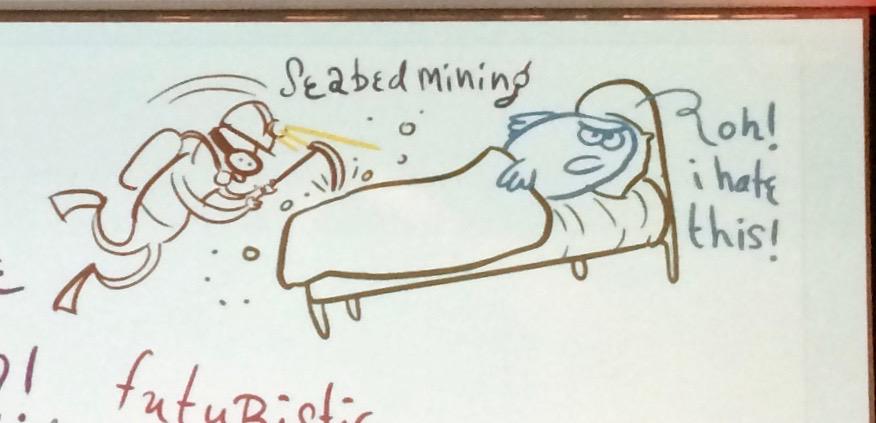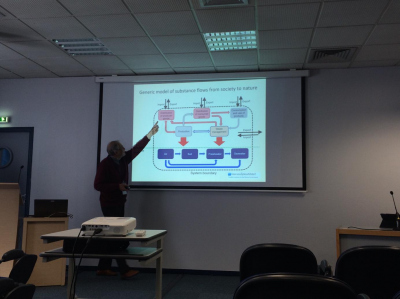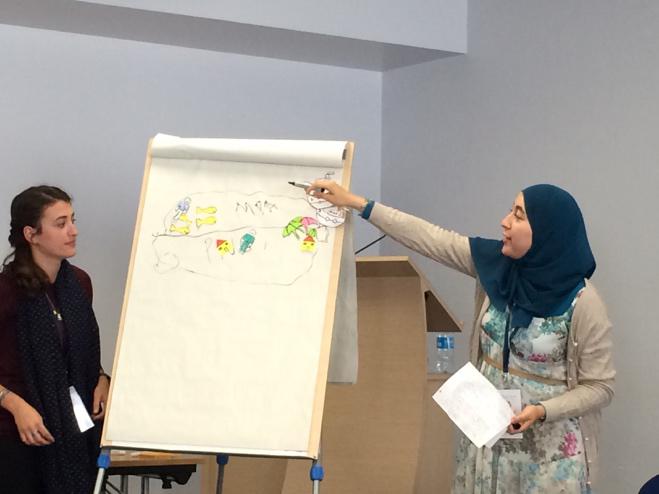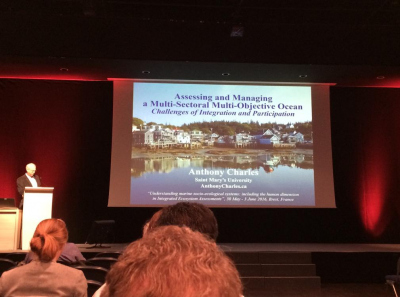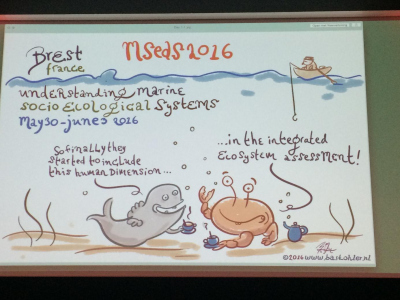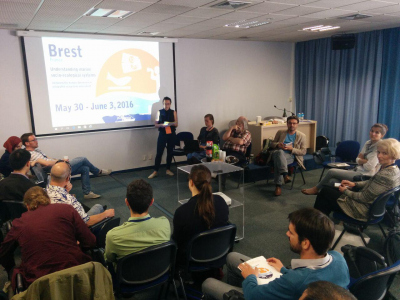Die Inhalte dieser Seite sind leider nicht auf Deutsch verfügbar.
Seitenpfad:
Luise Heinrich
Report of GLOMAR PhD student Luise Heinrich about her participation in the conference on ‘Understanding marine socio-ecological systems: including the human dimensions in Integrated Ecosystem Assessments (MSEAS 2016)’ in Brest, France from 30 May – 3 June 2016
From May 30th to June 3rd, 2016, I attended the conference on ‘Understanding marine socio-ecological systems: including the human dimensions in Integrated Ecosystem Assessments (MSEAS 2016)’ in Brest, (France), which was organized jointly by ICES, Ifremer and the University of Brest, among others. The conference focused on the integration of multiple disciplines, uses and sectors with regard to the coastal and marine environment. This included topics like coastal development, fisheries, oil and gas, mining, transport, and conservation. The conference comprised many interesting keynote speeches, research presentations and a young researchers workshop. At the conference I had the opportunity to present twice – first my master thesis research on the socio-economic impacts of ocean acidification and secondly my PhD research in the field of deep sea mining in the young researchers workshop.
The conference began on Monday morning (May 30th, 2016) with a keynote speech by Serge Garcia (IUCN Fisheries Expert Group) on the journey from a traditional natural scientific research focus to a broader socio-ecological perspective. The key note speech was then followed by a series of introductory talks by representatives of the OECD, the World Ocean Council, ICES and the Bedford Institute of Oceanography. The day ended with the first set of research presentations in a small number of parallel theme sessions.
The second day began with a keynote speech by Beth Fuller from (Commonwealth Scientific and Industrial Research Organisation) on the challenges associated with the modelling of socio-ecological systems, which was particularly interesting to me as it introduced a few methods that may be useful for my own research. After the keynote address the plenary split up and attended different parallel theme sessions.
My presentation on the socio-economic impacts of ocean acidification took place on this day in the theme session ‘Integration: lessons learned from practical case studies’. On the same day, I attended the first of three sessions of the young researchers workshop, which aimed at bringing together early career and senior scientists in order to discuss questions regarding the young researchers’ work. During the workshop I presented my PhD research on the socio-economic consequences of deep-sea mining and raised questions on possible ways to value the deep-sea environment. I received a lot of helpful comments and suggestions for methodological approaches.
The third day of the conference started with an interactive presentation by Linwood Pendelton (Univerity of Brest) on the differences between indicators, indices, and essential variables. This presentation was very interesting as it highlighted the issue of using different terminology among and even within disciplines. After the keynote speech the plenary again went to attend different theme sessions. Following this, I again attended the young researchers workshop.
The fourth day of the conference began with a keynote presentation by Edward H. Allison on the ‘Adventures in Integration: Unexpected Insights from Coastal and Marine Governance from Interdisciplinary Assessments’. The keynote speech was again followed by a variety of theme sessions and ended with another keynote address by Simon Levin who presented on the issue of public goods and common-pool resources in marine ecosystems. At the end of the conference day, I attended the last meeting of the young researchers workshop.
The very last day of the conference comprised a keynote presentation by Anthony Charles on assessing and managing a multi-sectoral multi-objective ocean and challenges for integration and participation a closing session.
Overall, I am really glad that I attended the MSEAS conference. Not only because I got to share both my master’s and PhD research with the scientific community but also because the conference had a focus on integrated approaches to science and was attended by a big number of scientists from a variety of backgrounds. Working at the intersection of natural, economic and social science and/or theory and practice is quite a new development and bringing together natural and social scientists to jointly approach environmental issues is challenging. At the MSEAS conference I met very interesting people and got some inspiration for my own research and career plan.
The conference began on Monday morning (May 30th, 2016) with a keynote speech by Serge Garcia (IUCN Fisheries Expert Group) on the journey from a traditional natural scientific research focus to a broader socio-ecological perspective. The key note speech was then followed by a series of introductory talks by representatives of the OECD, the World Ocean Council, ICES and the Bedford Institute of Oceanography. The day ended with the first set of research presentations in a small number of parallel theme sessions.
The second day began with a keynote speech by Beth Fuller from (Commonwealth Scientific and Industrial Research Organisation) on the challenges associated with the modelling of socio-ecological systems, which was particularly interesting to me as it introduced a few methods that may be useful for my own research. After the keynote address the plenary split up and attended different parallel theme sessions.
My presentation on the socio-economic impacts of ocean acidification took place on this day in the theme session ‘Integration: lessons learned from practical case studies’. On the same day, I attended the first of three sessions of the young researchers workshop, which aimed at bringing together early career and senior scientists in order to discuss questions regarding the young researchers’ work. During the workshop I presented my PhD research on the socio-economic consequences of deep-sea mining and raised questions on possible ways to value the deep-sea environment. I received a lot of helpful comments and suggestions for methodological approaches.
The third day of the conference started with an interactive presentation by Linwood Pendelton (Univerity of Brest) on the differences between indicators, indices, and essential variables. This presentation was very interesting as it highlighted the issue of using different terminology among and even within disciplines. After the keynote speech the plenary again went to attend different theme sessions. Following this, I again attended the young researchers workshop.
The fourth day of the conference began with a keynote presentation by Edward H. Allison on the ‘Adventures in Integration: Unexpected Insights from Coastal and Marine Governance from Interdisciplinary Assessments’. The keynote speech was again followed by a variety of theme sessions and ended with another keynote address by Simon Levin who presented on the issue of public goods and common-pool resources in marine ecosystems. At the end of the conference day, I attended the last meeting of the young researchers workshop.
The very last day of the conference comprised a keynote presentation by Anthony Charles on assessing and managing a multi-sectoral multi-objective ocean and challenges for integration and participation a closing session.
Overall, I am really glad that I attended the MSEAS conference. Not only because I got to share both my master’s and PhD research with the scientific community but also because the conference had a focus on integrated approaches to science and was attended by a big number of scientists from a variety of backgrounds. Working at the intersection of natural, economic and social science and/or theory and practice is quite a new development and bringing together natural and social scientists to jointly approach environmental issues is challenging. At the MSEAS conference I met very interesting people and got some inspiration for my own research and career plan.
The conference had its own cartoonist who tried to capture some of the presentations’ content
Anders Grimvall (Swedish Institute for the Marine Environment) presenting a model of substance flows from society to nature
Two North African participants presenting their research on participatory modeling in a nature park located along the Algerian coast during the young researchers workshop
Anthony Charles (St. Mary’s University, Canada) presenting on ‘Assessing and Managing a Multi-sectoral Multi-Objective Ocean’
The MSEAS conference as portrayed by the conference’s own cartoonist
Bas Kohler
The young researcher workshop



